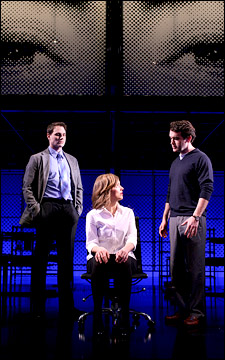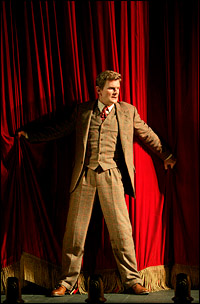
Adams lit the lights for three rock musicals currently running in New York: Broadway's Spring Awakening and Passing Strange and Off-Broadway's Next to Normal. He won a Tony Award last year for the first. And just to show that he's not a one-trick pony, Adams also did the intricate lighting effects that help create the spy world of 39 Steps at the Roundabout Theatre Company; the four shows make this the busiest time in Adams' career. The designer's world is not one of invisible effects unnoticed by the theatregoer. Adams trafficks in bare bulbs, fluorescent tubes and neon. In two of his current shows, audiences are confronted by an entire wall of light. The designer took some time to take to Playbill.com about his life of bright lights, big music.
Playbill.com: Next to Normal is only your latest collaboration with director Michael Greif.
Kevin Adams: Michael has me work on these very dark projects, these rock 'n' roll projects, and I sort of understand that I do those things well. I like him a lot. We have a lot in common.
Playbill.com: Yes, you certainly have developed a reputation for lighting rock and roll musicals — Passing Strange, Spring Awakening, Next to Normal.
KA: Yes I have. And Hedwig and the Angry Inch, too.
 |
||
| Scene from Next to Normal |
||
| photo by Joan Marcus |
KA: I've always enjoyed rock 'n' roll. I grew up listening to Hair and the cast albums of Tommy and Jesus Christ Superstar, and I would just listen and listen and listen until I wore them out. The spectacle of rock 'n' roll and bringing that to theatre, and having a narrative sung through with that kind of music is really interesting to me. It provides for a kind of spectacle and pop-ier cueing. Playbill.com: Spring Awakening must have seemed like odd material at first glance.
KA: I immediately understood that show. It was so clear to me that it was this 19th-century play with all this 19th-century stuff that was interrupted by these moments of 21st-century music. Playbill.com: What does that mean in terms of lighting?
KA: I thought there should be these 19th-century objects and costumes and settings, and then that would have within it these 21st-century, stripped-down, elegant lighting sculptures.
Playbill.com: Are there kinds of lighting that you come back to again and again, things that are your trademarks?
KA: Well, I'm really a self-taught lighting designer. I studied set design. I never had any interest in lighting shows. I lived in Los Angeles in the mid-80s after I graduated from Cal-Arts. And I started going to museums and I saw a lot of light and space work by these artists who worked in Los Angeles. In their work I saw a lot of fluorescent tubes and light bulbs and I started lighting my own sets using tubes and bulbs. That's kind of what I've been doing ever since. I've been working with — ?I call them electric objects. I work with neon and light bulbs and fluorescent tubes.
Playbill.com: Yes, I've noticed that your lighting is often very bare.
KA: It is. Very efficient and stripped down. And now, with these three pop shows running [Spring Awakening, Next to Normal, Passing Strange] most are lit with fluorescent light. There are about 1,300 light bulbs in Next to Normal and about a third of those are fluorescent. Passing Strange has a huge amount of fluorescent light. There's this huge light wall covered in fluorescent light and LED neon.
Playbill.com: So it's safe to say that your design world does not hinge on the right gel.
KA: Oh, I love color. All of that is about using color. And I use the right gel. (Laughs)
 |
||
| Scene from The 39 Steps. |
||
| photo by T. Charles Erickson |
KA: I really enjoyed it. I always wanted to put a Hitchcock film on stage. Frankly, I always wanted to put Psycho on stage. I also enjoyed putting the vocabulary of film noir on stage; I moved that cinematic period [of 39 Steps] just a little later so I could get a little more noirish influence in it. Playbill.com: How many cues are in 39 Steps?
KA: Gosh, I think there are about 150 or so. In Spring Awakening, there are about 300.
Playbill.com: Do you have any fear of being pigeonholed, that everyone's going to come to you with their rock musical?
KA: I'm really enjoying it. Ten years ago I became the rock guy [with Hedwig]. Even when I was doing Hedda Gabler on Broadway, the producers would say, "It's so rock 'n' roll, what you're doing." I was like "Oh God." Then for quite a few years I was lighting opera and plays and classics. This rock thing has sort of all come back again. It's very exciting. These are big projects. The producers are willing to put a lot of money into these funny things I want to do. They're very understanding and supportive.











